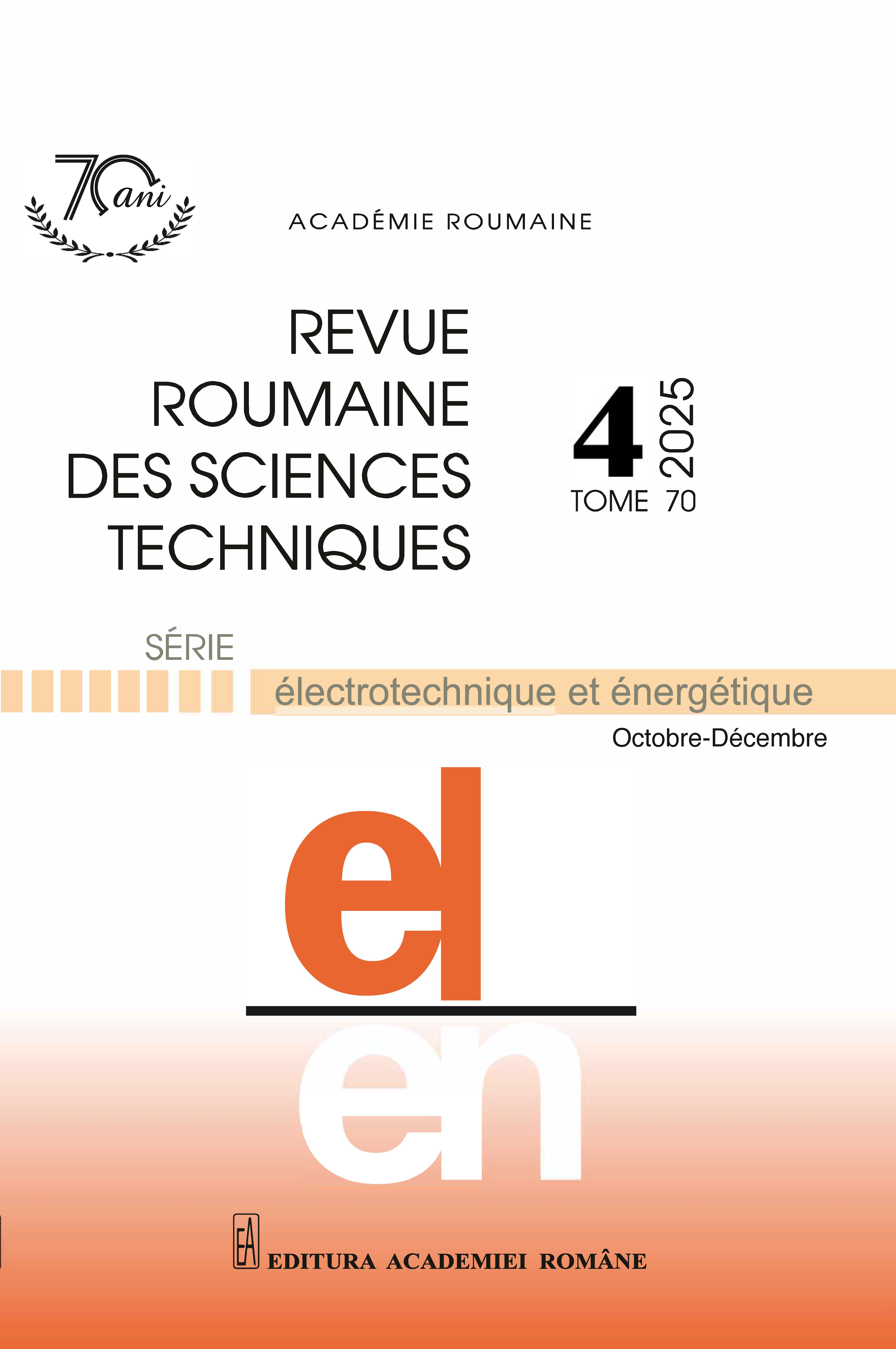DYNAMIC DE-EXCITATION PERFORMANCE OF BRUSHLESS SYNCHRONOUS MACHINES USING ADVANCED CONTROL STRATEGY
DOI:
https://doi.org/10.59277/RRST-EE.2025.4.12Keywords:
Synchronous generator, Brushless excitation, Voltage regulation, H∞ control, Fuzzy logic controllerAbstract
Synchronous generators (SG) are key electromechanical converters widely used in power plants, where precise excitation control is crucial for maintaining voltage regulation and stability. The main limitation of the conventional brushless excitation (CBE) system is its inability to supply negative voltages to the field winding, which limits fast de-excitation during sudden load rejection and causes terminal-voltage overshoots. To address this issue, this paper proposes an advanced fuzzy brushless excitation (FABE) system integrating fuzzy logic control (FLC) with H∞ control to enhance the transient and steady-state performance of synchronous generators. The H∞ controller ensures robustness against disturbances, parameter uncertainties, and nonlinearities, while the FLC improves adaptability and dynamic response. The proposed hybrid approach enables faster de-excitation, reduced voltage peaks, and improved damping of oscillations. Simulation results demonstrate that the FABE system clearly outperforms the conventional excitation method in terms of voltage stability, dynamic response, and overall control performance under various operating conditions.
References
(1) C.H.T. Lee, K.T. Chau, C. Liu, and C.C. Chan, Overview of magnetless brushless machines, IET Electric Power Appl., 12, pp. 1117–1125 (2018).
(2) C.A. Platero, M. Redondo, F. Blázquez, and P. Frías, High-speed de-excitation system for brushless synchronous machines, IET Elect. Power Appl., 6, pp. 156–161 (2012).
(3) E. Rebollo, C.A. Platero, D. Talavera, and R. Granizo, Use of discharge resistor to improve transient de-excitation in brushless synchronous machines, Energies, 12, 13, pp. 2528 (2019).
(4) E. Rebollo and C.A. Platero, Wireless supervision of a rotating high-speed de-excitation system for brushless SM, In International Conference on Electrical Machines (ICEM), Chalmers in Sweden (2020).
(5) S.E. Chouaba and A. Barakat, Advanced brushless excitation system with dynamic de-excitation capability, International Review of Electrical Engineering, 14, 2, pp. 1636 (2019).
(6) S.E. Chouaba and A. Barakat, Controlled brushless de-excitation structure for synchronous generators, Eng. Technol. Appl. Sci. Res., 9, 3, pp. 4218–4224 (2019).
(7) G.M. Ngaleu, A novel brushless de‐excitation system for synchronous generators using a buck chopper with a freewheeling discharge resistor, IET Electr. Power Appl., 17, 3, pp. 314–329 (2023).
(8) J.K. Nøland, E.F. Alves, A. Pardini, and U. Lundin, Unified reduced model for a dual-control scheme of the high-speed response brushless excitation system of synchronous generators, IEEE Trans. on Industrial Electronics, 67, 6, pp. 4474–4484 (2020).
(9) O.K. Krinah, R. Lalaloul, Z. Ahmida, and S. Oudina, Performance investigation of a wind power system based on double-feed induction generator: fuzzy versus proportional integral controllers, Rev. Roum. Sci. Techn. – Électrotechn. Et Énerg., 67, 4 (2022).
(10) A. Derbane, B. Tabbache, and A. Ahrichea, Fuzzy logic approach based direct torque control and five-leg voltage source inverter for electric vehicle powertrain, Rev. Roum. Sci. Techn. – Électrotechn. Et Énerg., 66, 1, pp. 15–20 (2021).
(11) A. Akka, H. Lallouani, O. Moussa, and A. Bouzidi, Interval type-2 fuzzy logic control for brushless doubly fed induction generator based on wind energy conversion systems, Rev. Roum. Sci. Techn. – Électrotechn. Et Énerg., 70, 3, pp. 307–311 (2025).
(12) C. Mama, A. Chaouch, and B. Benaissa, Comparison of the various controls of the switched reluctance motor 12/8, Rev. Roum. Sci. Techn. – Électrotechn. Et Énerg., 68, 1, pp. 52–57 (2023).
(13) Kentli, Studies on fuzzy logic control of electrical machines in Turkish Universities: an overview, Mathematical and Computational Applications, 16, 1, pp. 236–247 (2011).
(14) Hazzab, A. Laoufi, I.K. Bousserhane, and M. Rahli, Real-time implementation of fuzzy gain scheduling of PI controller for induction machine control, International Journal of Applied Engineering Research, 1, 1, pp. 51–60 (2006).
(15) Khelloufi, B. Sari, and S.E. Chouaba, Structured H∞ control-based robust power system stabilizer for stability of multi-machine system, Rev. Roum. Sci. Techn. – Électrotechn. Et Énerg., 69, 1, pp. 91–96 (2024).
(16) Barakat, S. Tnani, G. Champenois, and E. Mouni, Monovariable and multivariable voltage regulator design for a synchronous generator modeled with fixed and variable loads, IEEE Trans. Energy Convers., 26, 3, pp. 811–821 (2011).
(17) R.W. Beaven, M.T. Wright, and D.R. Seaward, Weighting function selection in the H∞ design process, Control Eng. Practice, 4, 5, pp. 625–633 (1996).
(18) D.W. Gu, P.H. Petkov, and M.M. Konstantinov, Robust control design with MATLAB, Springer, New York (2005).
Downloads
Published
Issue
Section
License
Copyright (c) 2025 REVUE ROUMAINE DES SCIENCES TECHNIQUES — SÉRIE ÉLECTROTECHNIQUE ET ÉNERGÉTIQUE

This work is licensed under a Creative Commons Attribution-NonCommercial-NoDerivatives 4.0 International License.


